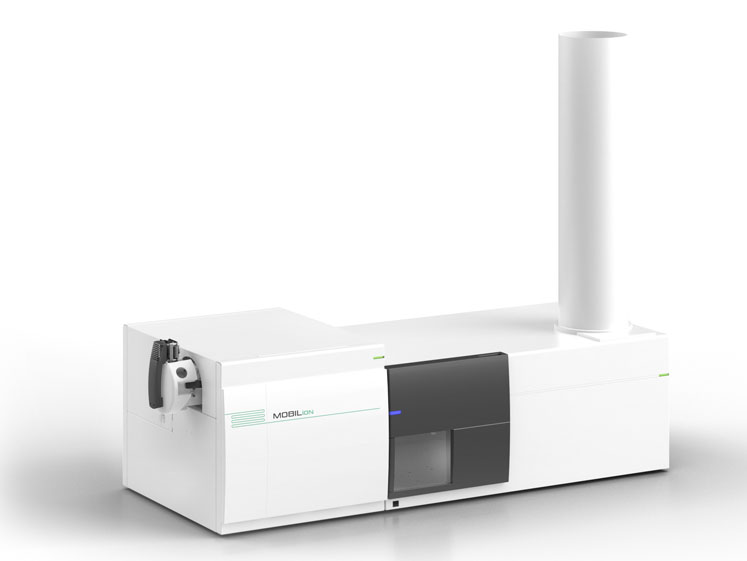In this interview, the inventor of SLIM, Dr Richard D. Smith, Director of Proteomics Research at Pacific Northwest National Laboratory (PNNL), takes Dr Kevin Robinson through the development of SLIM technology and how his team achieved its breakthrough of turning ions around corners.
Dr Melissa Sherman, CEO of MOBILion Systems, goes on to talk about the upcoming launch of the company’s first SLIM-based commercial product and how it’s being used to accelerate the development of new therapies and diagnostics. MOBILion Systems has exclusive access to the SLIM technology.
KSR: Can you take us back to the beginning of your work on SLIM, and give us an insight into the inspiration behind it; what was the need you were trying to address?
RDS: In many ways, SLIM represents a radical departure from how things have been done previously; but, to be honest, it’s difficult to pin down the exact genesis — a combination of middle-of-the-night thoughts and conversations with coworkers. Essentially, it’s the product of an environment in which we’re continually confronted with significant challenges and wherein we also have the ability to explore new ideas and approaches.
In our lab at PNNL, we work largely in areas of biomedical research that often involve the measurements of large and complex mixtures of proteins (in proteomics) and metabolites (in metabolomics).
Our analyses typically use liquid chromatography (LC) for separations in conjunction with mass spectrometry (MS) for detailed characterisation … and there are many significant challenges here. In my experience, the kind of applications we are faced with almost always benefit from better separations.
KSR: Tell us more about the technical challenges you encountered while developing SLIM.
RDS: A key challenge was the separation resolution or resolving power. Although ion-mobility spectrometry (IMS) separations can be really fast, they have often lacked the resolving power needed to be really useful.

Dr Richard D. Smith
Using much longer path lengths gives higher resolution but can lead to significant ion losses. Using an ion funnel certainly achieves better separations; but, often, the paths involved become far too long to be practical. We wanted to achieve the same results — confined ions without loss — but with a compact pathlength and without sacrificing performance.
KSR: How did you achieve the breakthrough of turning ions around corners?
RDS: This was the key development and was actually relatively fast. First, we developed a physical electrode arrangement on surfaces to create electric fields that emulated conventional (drift field) IMS, then realised that the electrode arrangement also needed to make 90-degree turns.
This first implementation was limited and quickly stimulated a second version using a low voltage dynamic electric field with a sine wave shape. We initially showed that we could obtain good separations with a short straight path in SLIM, then developed a system with which we could make 90-degree turns without either the loss of ions or resolving power.
Importantly, with an electrode pattern that moved ions using dynamic low voltage fields, there was also a benefit of no length limitations. We could then develop a compact “serpentine” arrangement with many turns that offers ultrahigh resolving powers.
KSR: It must be great for you to see the SLIM technology becoming more accessible through MOBILion.
RDS: It’s really exciting to see that the SLIM technology is going to become broadly available, and also to see the additional refinements that MOBILion is making.
Putting the theory into practice
KSR: Tell us about MOBILion Systems and the SLIM-based HRIM-MS technology that you are commercialising.
MS: We established MOBILion Systems in 2017 and spent some time transferring the technology from Dick Smith’s lab at PNNL in Richland (WA, US) to our headquarters in the Philadelphia biotech corridor.
From 2018 to 2019, we were absorbed in full product development, which required re-engineering every aspect of the research prototype so that the product was manufacturable, robust and scalable. In 2020, we launched our first product prototype to early adopters and here we are today, in 2021, with our upcoming full commercial product launch.
MOBILion is a dynamic company whose team is incredibly passionate about developing analytical instruments that help our customers to better predict, diagnose and treat disease.
We are commercialising a fast, efficient, super-high-resolution separation technology that makes it easier to separate and identify the most challenging molecules that are difficult to detect but also have clinical significance.
The easiest way to think about what we are doing is that we digitise separations. We perform separations in the gas phase on printed circuit boards, allowing us to deliver easier, automated, software-driven methods with better resolution, faster analysis times, greater instrument uptime and more reproducible results.
KSR: What are the key advantages of HRIM-MS and what potential do you see for it?
MS: The classic techniques are too slow, too complicated and/or not powerful enough to address molecular and structural characterisation challenges adequately.

Melissa Sherman
In the areas of biotherapeutic drug development, early disease detection and clinical diagnostic markets, our customers often have to make a trade-off. Incumbent separation systems might provide adequate throughput or resolution or ease-of-use, but not all three at the same time; hence the trade-off.
In HRIM separations, we’re able to put 13 metres of ion separation path length in a component that measures 14 x 18 inches; this allows us to separate molecules that have very minor differences.
We can therefore separate and identify molecules that other instruments fail to detect, as well as providing a deeper level structural information.
From a throughput perspective, our analysis times are around 2–5 minutes, compared with liquid chromatography separations that can range from 15 minutes to as much as 2 hours for more complicated separations.
We have greater instrument uptime and are analyte agnostic, so it is a universally applicable analysis set-up that does not require changing out components when dealing with multiple analyte classes.
From an ease-of-use perspective, there is less hands-on time required. No complex chemistry is needed and the software-driven, push-button methods make it easier for a less skilled operator to set up, use the equipment and interpret the results.
LC has hundreds of moving parts; HRIM has none. The incorporation of HRIM into the workflow allows for reduced reliance on LC for the separation of complex biological matrices.
This greatly improves both reliability and reproducibility in the lab. With better reproducibility comes more confidence in results. High resolution separation has also been shown to isolate out isobaric matrix interferences in complex biological matrices, providing additional confidence in data that LC-MS alone cannot provide.
Our technology provides the highest resolution ion mobility separations for the broadest mass range compared with other ion mobility technology platforms.
Because we achieve such high resolution, we are uniquely positioned to minimise the dependency on chromatographic separations for some applications.
Users can now separate and identify molecules that were indistinguishable with other techniques or see the molecules that they were able to with LC, but much easier, faster and with greater reproducibility.
KSR: What applications are you focusing on now with HRIM-MS?
MS: We are currently focusing on addressing the characterisation challenges faced during biopharmaceutical drug development, manufacturing and quality monitoring.
Our technology has been shown to provide a high-throughput and high-resolution adjunct to conventional LC-MS systems for the separation and analysis of proteins, peptides, glycans and post-translational modifications. We are focused on delivering faster, easier, more robust methods for critical quality attribute analysis to help our customers bring safer, more efficacious drugs to market faster.
Our technology is proving to be extremely beneficial for those working with challenging analyte classes. For example, glycans have a lot of isomers and lots of structures that are similar, so it can take long chromatographic processes to tease them apart.
In glycan analysis workflows, there is a clear need for faster techniques that produce better resolving power.
HRIM-MS has shown tremendous potential for the seamless separation of glycans followed by structural determination in both biomedical and clinical research.
The full characterisation of glycan structures is not only essential for biopharmaceuticals, but also for biomarker identification. The determination of glycan isomers that are indicative of disease states can take up to 2 hours using LC gradients alone.
The introduction of HRIM-MS can accelerate this process 100-fold (with a typical run taking just 2 minutes), increasing the speed at which new biomarkers are identified and expediting the translation of validated biomarkers from research to the clinical lab.
Our technology has also been used in targeted lipidomic workflows to separate isomeric gangliosides, which are challenging molecules to separate using LC-MS approaches because of their very small differences in structure.
One recent publication discusses the use of HRIM-MS to separate isomeric species of gangliosides without the use of LC. With a Flow Injection Analysis (FIA) HRIM-MS workflow, it’s possible to resolve these previously indistinguishable molecules in approximately 2 minutes.
Along with this significant improvement in analysis time, the removal of LC from the workflow makes the technique much easier to contemplate when transferring an HRIM-MS based assay to a diagnostic lab.
KSR: What applications are you working on for the future?
MS: The SLIM-based HRIM platform technology is uniquely tuneable and customisable. By changing the electrode pattern and the control electronics, we have a “smart” technology that is able to manipulate ions in nearly endless combinations and permutations, enabling us to develop fit-for-purpose concepts.

The sky’s the limit with respect to the analytical separations we can achieve because of the flexibility of the HRIM technology form factor. We have multiple generations of HRIM product concepts in the pipeline that will expand our addressable market and application opportunities.
Because we are able to achieve such high resolution, we can reduce reliance on liquid chromatography separations and high-resolution mass analysis for analytical measurements, subsequently changing the conventional wisdom of LC-MS instrument workflows.
KSR: Can you tell us a little bit about the early adopters of HRIM-MS and how they are using the technology in their work?
MS: Despite the COVID-19 pandemic, we were able to work with our early adopters — Vanderbilt University and the University of Georgia’s Complex Carbohydrate Research Centre (CCRC) — and get five beta units out into the field in 2020.
At Vanderbilt, they’re focused on tackling the isomer problem, a prevailing challenge in lipidomics and metabolomics. Metabolites and lipids, for example, exhibit significant variation in molecular conformation, even when they have the same chemical formula. With HRIM-MS, it’s now possible to separate things like constitutional isomers and species such as diastereomers.
The CCRC at the University of Georgia’s primary focus is the characterisation of glycoproteins. The partnership between the CCRC and MOBILion Systems was set up to address several of the major problems they were dealing with, such as speed versus resolution issues.
With HRIM-MS, they have gone from a 3-hour run time to a 2-minute injection while improving the quality of their data with improved resolution for a number of isomeric compounds.
The CCRC has also been actively involved in research to better understand SARS-CoV-2, the infectious agent for COVID-19. They needed to be able to do much faster glycan analysis than the standard 6-hour separations.
Our technology is enabling them to detail the glycosylation microheterogeneity in the spike glycoprotein that decorates the surface of the SARS-CoV-2 viral capsid.
Using HRIM-MS, they have been able to achieve very high-resolution separation of the compounds of interest and dramatically increase throughput, leading to more meaningful results in a shorter amount of time.
We have also been collaborating with an international research team on a project funded by a grant from The Michael J. Fox Foundation. The research will include the use of our fast, high-resolution HRIM-MS platform to support the discovery of new biomarkers for Parkinson’s Disease.
KSR: When will the MOBILion instrument be commercially available?
MS: We’ve partnered with Agilent Technologies to integrate our product with Agilent’s Q-TOF mass spectrometry platform as our first commercial product offering.
This is the first of several partnerships through which we’ll integrate our ion mobility capabilities with industry leading mass spectrometry platforms. We have also announced our collaboration with Protein Metrics to provide faster, easier, push-button data analysis and processing for biopharma characterisation workflows.
MOBILion’s HRIM-MS platform will be commercially available in June 2021. We are excited to be bringing this game-changing technology to the masses and are confident that it is going to have a major impact on the biopharmaceutical quality monitoring and omics translational research markets.
